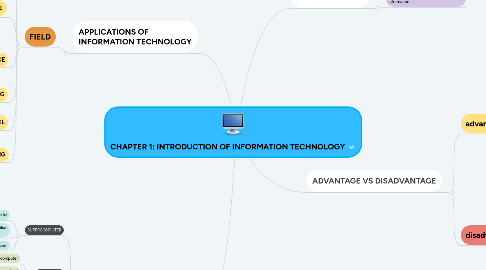
1. APPLICATIONS OF INFORMATION TECHNOLOGY
1.1. FIELD
1.1.1. EDUCATION
1.1.1.1. learning management system
1.1.1.2. computer based training
1.1.2. FINANCE
1.1.2.1. online banking
1.1.2.2. finance investment system
1.1.3. GOVERNMENT
1.1.3.1. E-filing
1.1.3.2. E-syariah
1.1.4. HEALTH CARE
1.1.4.1. Medline
1.1.4.2. Counter Registration System
1.1.4.3. Telemedicine
1.1.4.4. Telesurgery
1.1.5. SCIENCE
1.1.5.1. Virtual reality
1.1.5.2. Cochlear implant
1.1.5.3. Hawk Eye Officiating System
1.1.5.4. Neural network
1.1.6. PUBLISHING
1.1.6.1. Online Newspaper & Online Magazine
1.1.7. TRAVEL
1.1.7.1. Global Positioning System(GPS)
1.1.7.2. Online Reservation System
1.1.7.3. E-ticketing
1.1.8. MANUFACTURING
1.1.8.1. Computer-Aided Design
1.1.8.2. Computer Aided Manufacturing
2. CATEGORIES OF COMPUTERS
2.1. SUPERCOMPUTER
2.1.1. fastest and more powerful
2.1.2. process more than one quadrilion instruction in a single second
2.1.3. occupy a full room
2.2. MAINFRAME
2.2.1. large, expensive, powrfull computer
2.2.2. can handle humdreds or thousands of connected user simultaneuosly
2.2.3. occupy partial room
2.3. PERSONAL COMPUTER
2.3.1. can perform all of its input, processing, output and storage activity by itself
2.3.2. fits on a desk
2.4. MOBILE COMPUTER
2.4.1. fits on your lap
2.5. MOBILE DEVICES
2.5.1. fits in the palm of your hand or a pocket size
2.6. EMBEDDED COMPUTERS
2.6.1. it is mounted on a cicuit board
3. DEFINITION OF IT
3.1. the use of computer, hardware, and software to store, retrieve and manipulate information
4. ADVANTAGE VS DISADVANTAGE
4.1. advantage:
4.1.1. SPEED- many computers can process bilions or trilions of operations in a single second.
4.1.2. RELIABILITY- the electronic components in computers are dependable and reliable.
4.1.3. CONSISTENCY- a computer with same input will produce the same results consistently
4.1.4. COMMUNICATION- can communicate wirelessly with other computer and allow users to communicate with one another.
4.1.5. STORAGE- computers can store enomous amounts of data and make this data available for processing anytime is needed.
4.2. disadvantage:
4.2.1. VIOLATION OF PRIVACY- other person might steal our personal and confidental records if they were not protected properly.
4.2.2. PUBLIC SAFETY-we might be a victim to crime if we are exposing or sharing out photos,videos or other personal information publicly.
4.2.3. IMPACT ON LABOUR FORCE-many employee might jobless if their skills have been replaced by computers.
4.2.4. HEALTH RISK- prolonged or improper computer use can lead to health injuries.
4.2.5. IMPACT ON ENVIRONMENT- computer manufacturing process and computer waste can cause pollution.

